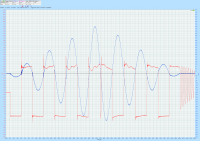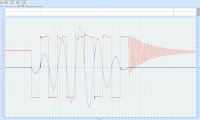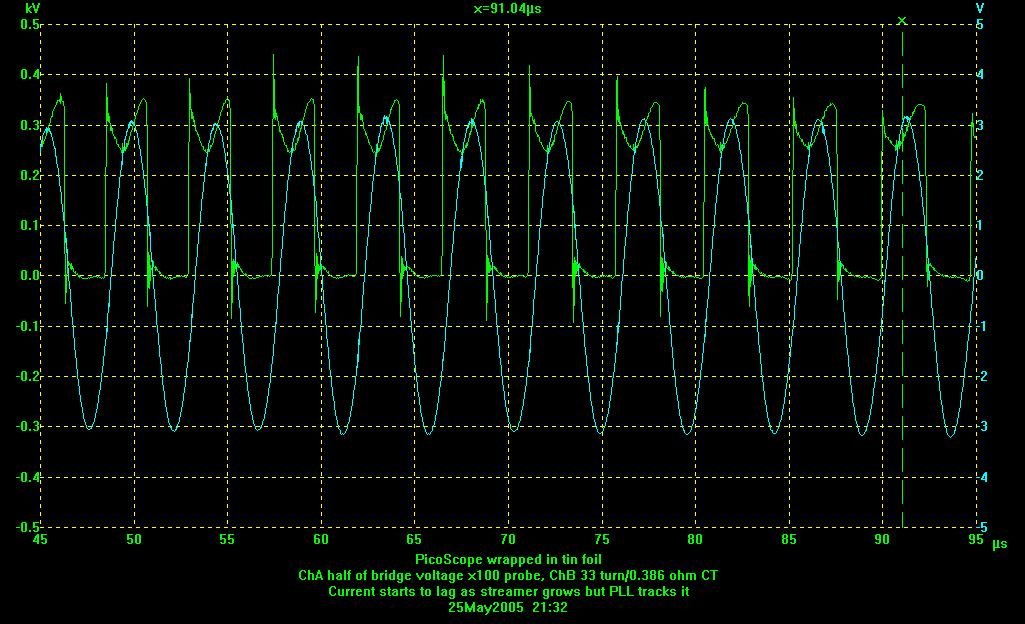
CM300 ringing question
Hydron, Mon Apr 07 2014, 01:23PMI've just rebuilt my DRSSTC bridge with a couple of CM300DY-24Hs, and am seeing more ringing (200V+) than I expected, as shown in the scope pic:

Can anyone tell me if spikes this large are normal for these CM300s running at ~70kHz, and are they likely to cause problems if I crank the bus up another 100-150V or so?
The bus should be reasonably low inductance (made out of a laminate of copper sheets and PCB), I have a 2uF Aerovox snubber on each IGBT, and the phase lead on the UD2.5 derived driver is adjusted about as well as possible (can knock another ~20 volts off the first spike at the expense of the rest), so I think I've covered most of the bases. I've even played with the gate resistors and diode with no improvement.
If I hadn't had this running before with different IGBTs (a couple of SKM200GB125Ds using the same bus layout) I'd probably just accept it as normal, but I saw such an enormous amount less ringing with the the faster SKM200 IGBTs (see second pic) that I'm wondering if I'm doing something wrong. If I'm really trying too hard with the CM300s I may need to change back, but I'd like the extra current rating and to save the SKM200s for other projects (e.g. hard switching).

Re: CM300 ringing question
Antonio, Mon Apr 07 2014, 03:28PM
Ringing where? The ringing after the burst is normal. The ondulations at the top seem strange, but may be caused by excessive ringing in the gate-source signals, or by the oscilloscope connections. Look carefully how the oscilloscope is connected. Verify if the bus voltages also show them. The gate signals are difficult to measure, but a good idea of how they are can be obtained by direct measurement with the bus power supply disconnected.
Antonio, Mon Apr 07 2014, 03:28PM
Ringing where? The ringing after the burst is normal. The ondulations at the top seem strange, but may be caused by excessive ringing in the gate-source signals, or by the oscilloscope connections. Look carefully how the oscilloscope is connected. Verify if the bus voltages also show them. The gate signals are difficult to measure, but a good idea of how they are can be obtained by direct measurement with the bus power supply disconnected.
Re: CM300 ringing question
Feathers, Mon Apr 07 2014, 06:07PM
My coils run cm300's at 75kHz, and that is pretty quick for these big bricks, especially the 1200V units, making it difficult to see much more improvement.
This kind of overshoot seems more or less normal. You will always have a spike on the first and/or second cycles as the phase lead network begins doing its thing, but I wouldn't worry about 800V on a 1200V IGBT.
The real question is how quick is your scope! You can only keep the spikes in check that are slow enough to see, I've made that mistake before :P
Feathers, Mon Apr 07 2014, 06:07PM
My coils run cm300's at 75kHz, and that is pretty quick for these big bricks, especially the 1200V units, making it difficult to see much more improvement.
This kind of overshoot seems more or less normal. You will always have a spike on the first and/or second cycles as the phase lead network begins doing its thing, but I wouldn't worry about 800V on a 1200V IGBT.
The real question is how quick is your scope! You can only keep the spikes in check that are slow enough to see, I've made that mistake before :P
Re: CM300 ringing question
Hydron, Mon Apr 07 2014, 08:17PM
Sorry, should have made it clear that i'm talking about the spikes at the switching transitions (when zoomed in on the scope they're a few cycles at ~13MHz, caused by what I'm assuming are stray inductance in the bus and IGBT ringing with various capacitors when the switching isn't bang on the zero crossing).
I'm assuming the undulations are caused by pulling 500+ amps from the bus capacitance. They can be seen when scoping the bus, along with spikes at the switching transitions. The undulations are certainly not caused by the gate drive, I've actually scoped the gate signals already, though not with power on the bus. Incidentally the nicest looking gate drive waveforms didn't produce the smallest spikes on the output, to get the best results I had to tolerate some overshoot (I played around with the gate resistors and diode a bit).
Yeah, I thought it could just be that I'm asking a lot from the IGBTs, but I'd had such clean waveforms with the quicker ones that I wanted to get a second opinion. The 800V stuff is fine, but I wanted to run the bus at full doubled 230V mains, which pushes the spikes up to ~900V, which makes me nervous.
As for the scope, it could be a bit quicker (only 100MHz bandwidth/100MSPs sampling), but it should be just enough for this, and was running full speed for capturing the waveforms I posted.
Hydron, Mon Apr 07 2014, 08:17PM
Antonio wrote ...
Ringing where? The ringing after the burst is normal. The ondulations at the top seem strange, but may be caused by excessive ringing in the gate-source signals, or by the oscilloscope connections. Look carefully how the oscilloscope is connected. Verify if the bus voltages also show them. The gate signals are difficult to measure, but a good idea of how they are can be obtained by direct measurement with the bus power supply disconnected.
Ringing where? The ringing after the burst is normal. The ondulations at the top seem strange, but may be caused by excessive ringing in the gate-source signals, or by the oscilloscope connections. Look carefully how the oscilloscope is connected. Verify if the bus voltages also show them. The gate signals are difficult to measure, but a good idea of how they are can be obtained by direct measurement with the bus power supply disconnected.
Sorry, should have made it clear that i'm talking about the spikes at the switching transitions (when zoomed in on the scope they're a few cycles at ~13MHz, caused by what I'm assuming are stray inductance in the bus and IGBT ringing with various capacitors when the switching isn't bang on the zero crossing).
I'm assuming the undulations are caused by pulling 500+ amps from the bus capacitance. They can be seen when scoping the bus, along with spikes at the switching transitions. The undulations are certainly not caused by the gate drive, I've actually scoped the gate signals already, though not with power on the bus. Incidentally the nicest looking gate drive waveforms didn't produce the smallest spikes on the output, to get the best results I had to tolerate some overshoot (I played around with the gate resistors and diode a bit).
Feathers wrote ...
My coils run cm300's at 75kHz, and that is pretty quick for these big bricks, especially the 1200V units, making it difficult to see much more improvement.
This kind of overshoot seems more or less normal. You will always have a spike on the first and/or second cycles as the phase lead network begins doing its thing, but I wouldn't worry about 800V on a 1200V IGBT.
The real question is how quick is your scope! You can only keep the spikes in check that are slow enough to see, I've made that mistake before :P
My coils run cm300's at 75kHz, and that is pretty quick for these big bricks, especially the 1200V units, making it difficult to see much more improvement.
This kind of overshoot seems more or less normal. You will always have a spike on the first and/or second cycles as the phase lead network begins doing its thing, but I wouldn't worry about 800V on a 1200V IGBT.
The real question is how quick is your scope! You can only keep the spikes in check that are slow enough to see, I've made that mistake before :P
Yeah, I thought it could just be that I'm asking a lot from the IGBTs, but I'd had such clean waveforms with the quicker ones that I wanted to get a second opinion. The 800V stuff is fine, but I wanted to run the bus at full doubled 230V mains, which pushes the spikes up to ~900V, which makes me nervous.
As for the scope, it could be a bit quicker (only 100MHz bandwidth/100MSPs sampling), but it should be just enough for this, and was running full speed for capturing the waveforms I posted.
Re: CM300 ringing question
Steve Conner, Tue Apr 08 2014, 09:48AM
I think the spikes are normal, especially if the switching isn't exactly at zero current. It is pretty much impossible to achieve ZCS for the first cycle or so. Also, the CM300 could have more package inductance, or more reverse recovery charge in its diodes, than the Semikron.

This shows an extreme example from the early development of my PLL driver. It is still running 9 years later on the original set of IGBTs
The "undulations" are basically the primary current differentiated. They are the L*di/dt voltage drop across the inductance of the IGBT package and DC bus wiring.
Steve Conner, Tue Apr 08 2014, 09:48AM
I think the spikes are normal, especially if the switching isn't exactly at zero current. It is pretty much impossible to achieve ZCS for the first cycle or so. Also, the CM300 could have more package inductance, or more reverse recovery charge in its diodes, than the Semikron.

This shows an extreme example from the early development of my PLL driver. It is still running 9 years later on the original set of IGBTs

The "undulations" are basically the primary current differentiated. They are the L*di/dt voltage drop across the inductance of the IGBT package and DC bus wiring.
Re: CM300 ringing question
teravolt, Tue Apr 08 2014, 04:41PM
If the ringing is on your gates, add 100 ohms in parallel to dampen the ringing. you can also add 10 ohms in series to also dampen but it may affect gate rise time
teravolt, Tue Apr 08 2014, 04:41PM
If the ringing is on your gates, add 100 ohms in parallel to dampen the ringing. you can also add 10 ohms in series to also dampen but it may affect gate rise time
Re: CM300 ringing question
HV Enthusiast, Thu Apr 10 2014, 03:35PM
Just switch the oscilloscope bandwidth to 20MHz. That should fix the problem! HAHA
HV Enthusiast, Thu Apr 10 2014, 03:35PM
Just switch the oscilloscope bandwidth to 20MHz. That should fix the problem! HAHA
Re: CM300 ringing question
Hydron, Sun Apr 13 2014, 05:31AM
Thanks for the responses, looks like what I'm seeing is expected and acceptable.
The coil has been run this weekend at ~600-650V on the bus with no issues, so I'll just leave it be and stop worrying.
Hydron, Sun Apr 13 2014, 05:31AM
Thanks for the responses, looks like what I'm seeing is expected and acceptable.
The coil has been run this weekend at ~600-650V on the bus with no issues, so I'll just leave it be and stop worrying.
Re: CM300 ringing question
Dr. Dark Current, Mon Apr 14 2014, 10:07AM
The spikes you see could be interference to the scope. Connect the probe tip to the ground clip (leave the ground clip in the circuit) and measure again. Running a few loops of the probe cable through a ferrite toroid can help to eliminate common mode interference problems.
P.S. The overshoot magnitude depends almost exclusively on the turn-off current, so if you crank the voltage up and keep peak current the same, the overshood should not increase much.
Dr. Dark Current, Mon Apr 14 2014, 10:07AM
The spikes you see could be interference to the scope. Connect the probe tip to the ground clip (leave the ground clip in the circuit) and measure again. Running a few loops of the probe cable through a ferrite toroid can help to eliminate common mode interference problems.
P.S. The overshoot magnitude depends almost exclusively on the turn-off current, so if you crank the voltage up and keep peak current the same, the overshood should not increase much.
Print this page